Archive
Posts Tagged ‘trustworthy behavior’
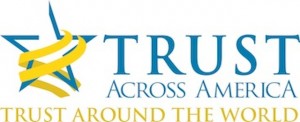
What’s that expression….”Kids say the darnedest things?” Well so do adults.
Lately, I’ve heard and seen some great examples of trust-busting comments and actions. They generally fall into one of these categories:
- Bad-mouthing a coworker, colleague, competitor or better yet, your boss
- Placing blame before all the facts have been gathered
- Spinning the truth
- Speaking with “big” meaningless words (psychobabble)
- Crying wolf
- Taking undeserved credit
- Fast finger pointing
- Pleading the “5th”
- Refusing to admit a mistake or apologize
- Pulling a “disappearing act” or playing the “silence” game.
How many times in the course of a day do you sound or appear untrustworthy? Learn to think before you speak, and consider the potential consequences of your actions. These are quick, easy and simple ways to build trust.
Barbara Brooks Kimmel is the Executive Director of Trust Across America-Trust Around the World whose mission is to help organizations build trust. She is also the editor of the award winning TRUST INC. book series. In 2012 Barbara was named “One of 25 Women Changing the World” by Good Business International.
. 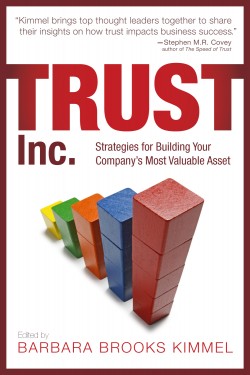
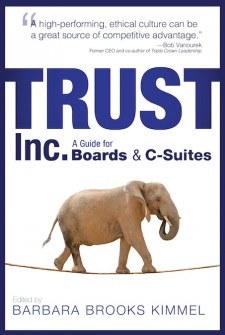
Should you wish to communicate directly with Barbara, drop her a note at Barbara@trustacrossamerica.com
Copyright © 2014, Next Decade, Inc.
Barbara Brooks Kimmel, barbara kimmel, corporate reputation, trust, trust across america, Trust Inc. A Guide for Boards & C-Suites, Trust Inc. Strategies for Building Your Company's Most Valuable Asset, trustworthy behavior

“When a business that’s comfortable not having 100% market share happily recommends a competitor, they’re sending a signal about trust and confidence and most of all, about feeding the community first.” This is a quote from a recent Seth Godin blog post.
If you are an entrepreneur, small business owner or consultant interested in building trust, ask yourself these two questions:
Do I spend all of my time promoting myself only?
If your answer is “yes”, I can almost assure you that this strategy may work in the short-term, but will present serious challenges long-term. It shows low self-confidence, an unwillingness to share and learn, and you will potentially bust trust with those you view (right or wrong) as competition.
Do I spend some of my time recommending others in my professional community who may have more targeted experience, resources or products, and will do a better job than I can?
If your answer is “yes,” you understand that trust is reciprocal and you are willing to take a “risk” that may pay off and lead to longer-term success. If we want to help ideas spread, if we want to change the world, we must do it together. Park your self-interest (along with your ego) at the door and try collaboration instead. The payoff may not be as quick and easy but the long-term rewards will be well worth it.
Barbara Brooks Kimmel is the Executive Director of Trust Across America-Trust Around the World whose mission is to help organizations build trust. She is also the editor of the award winning TRUST INC. book series and the Executive Editor of TRUST! Magazine. In 2012 Barbara was named “One of 25 Women Changing the World” by Good Business International.
Should you wish to communicate directly with Barbara, drop her a note at Barbara@trustacrossamerica.com
Copyright © 2014, Next Decade, Inc.
Barbara Brooks Kimmel, barbara kimmel, Collaboration, leadership, organizational trust, seth godin, trust, trust across america, Trust Inc. A Guide for Boards & C-Suites, Trust Inc. Strategies for Building Your Company's Most Valuable Asset, trustworthy behavior
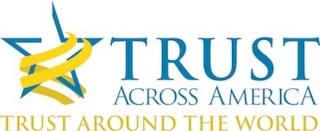
September is “Thoughtful Conversation” Month
according to Trust Across America’s
Your stakeholders need not know the company’s trade secrets, or what the CEO had for dinner, but if your company is serious about increasing trustworthiness, consider engaging all your stakeholders in rich, thoughtful conversations. View them as vital contributors to a better organization.
During the 52 weeks of 2014 you can build trust in your organization by thinking about, discussing and following the advice of the experts. Below are weekly reflections on trust for September 2014.
- Week 1: Cooperation is the central mode of working, and mutual trust and true sustainability are our measures of success. Philip Mirvis, Organizational Psychologist
- Week 2: The capacity of brands to build trust among stakeholders depends on a company’s ability to build an army of advocates. Brian Moriarty, Business Roundtable Institute for Corporate Ethics
- Week 3: The level of organizational trust has a direct correlation with the top leader’s sincerity of purpose and values. Rajeev Peshawaria, The Iclif Leadership & Governance Centre, Malaysia
- Week 4: The crisis of trust is a crisis of leadership Robert Phillips, Jericho Chambers
- Week 5: We should always be moving to create high trust environments. Steven N. Pyser, JD, Temple University
Please share your comments and suggestions! Email: barbara@trustacrossamerica.com
Barbara Brooks Kimmel is the Executive Director of Trust Across America-Trust Around the World whose mission is to help organizations build trust. She is also the editor of the award winning TRUST INC. book series. In 2012 Barbara was named “One of 25 Women Changing the World” by Good Business International.
. 

Copyright © 2014, Next Decade, Inc.
Barbara Brooks Kimmel, barbara kimmel, Brian Moriarty, business roundtable institute, Iclif Leadership & Governance Centre, leadership, organizational trust, philip mirvis, rajeev peshawaria, Robert Phillips, Steven N. Pyser, trust, trust across america, trust in business, Trust Inc. A Guide for Boards & C-Suites, Trust Inc. Strategies for Building Your Company's Most Valuable Asset, trustworthy behavior

Late last year Trust Across America-Trust Around the World published the first in a planned series of award-winning books. TRUST INC., Strategies for Building Your Company’s Most Valuable Asset brings together the wisdom of 32 experts. Six months later we released our second book, Trust Inc. A Guide for Boards & C-Suites. In this book, sixty experts have joined forces to offer 100 strategies.
Throughout the month of August, we will be featuring 31 essays from our second book. Each stands alone as an excellent resource in guiding Boards and C-Suites on driving a trust agenda at the highest level in the organization, and provides tools for those who choose to implement trust-building programs in their organization.
This twenty-second essay brings advice from Doug Turner who has spent over 30 years in procurement and contract management working on high-tech and aviation projects all over the world. He is now credentialed by the International Coach Federation, and has helped corporations achieve success in setting up new businesses, and winning very large business contracts through the development of strong trusting relationships with customers and suppliers. Doug has been a featured speaker and instructor with the Supply Chain Management Association of Canada and the International Association for Commercial and Contract Management (IACCM). Doug is also a member of the Alliance of Trustworthy Business Experts.
Trust and Public Rewards
One of the key responsibilities of the CEO and C-Suite is to create and maintain the kind of culture needed to achieve the mission of the organization. To do this, they must articulate what is expected and then demonstrate what success looks like. In order for staff to trust and embrace what the leaders are saying, staff must see that the leaders are genuine and that they are believable.
To achieve this trust, leaders must pay close attention to the kind of behaviors that are seen to be, or perceived by staff to be, rewarded. Visibly rewarding examples of the requested behavior goes a long way to establish believability and remaining consistent over time helps to establish the integrity leaders must show to engender trust. (Covey, www.thespeedoftrust.com.) Leaders must not ask for one thing and then reward, or even be perceived to reward, something that is different and possibly inconsistent with what is requested.
If, for example, greater “creativity” is desired in the culture, executives must go to special lengths to publically acknowledge and reward staff who show exemplary imagination, whether their initiatives are ultimately successful or not. Results obtained through “tried and true” methods would therefore not be unduly acknowledged. Similarly, by visibly rewarding shining examples of “collaboration”, “high standards”, “customer focus”, or whatever else may be desired, the CEO will build that aspect into the culture as a result of enhanced levels of trust.
I hope you have enjoyed this next sneak peak into our second book. If this brief look behind the door has been helpful, follow this link to order both of our books online.
Barbara Brooks Kimmel is the Executive Director of Trust Across America-Trust Around the World whose mission is to help organizations build trust. She is also the editor of the award winning TRUST INC. book series. In 2012 Barbara was named “One of 25 Women Changing the World” by Good Business International.
. 

Should you wish to communicate directly with Barbara, drop her a note at Barbara@trustacrossamerica.com
Copyright © 2014, Next Decade, Inc.
Alliance of Trustworthy Business Experts, Barbara Brooks Kimmel, barbara kimmel, Doug Turner, leadership, organizational trust, trust, trust across america, trust in business, Trust Inc. A Guide for Boards & C-Suites, Trust Inc. Strategies for Building Your Company's Most Valuable Asset, trustworthy behavior

Late last year Trust Across America-Trust Around the World published the first in a planned series of award-winning books. TRUST INC., Strategies for Building Your Company’s Most Valuable Asset brings together the wisdom of 32 experts. Six months later we released our second book, Trust Inc. A Guide for Boards & C-Suites. In this book, sixty experts have joined forces to offer 100 strategies.
Throughout the month of August, we will be featuring 31 essays from our second book. Each stands alone as an excellent resource in guiding Boards and C-Suites on driving a trust agenda at the highest level in the organization, and provides tools for those who choose to implement trust-building programs in their organization.
This twenty-first essay brings advice from Bob Whipple, CEO of Leadergrow Inc a company dedicated to improving leadership in organizations. He is also a professional speaker and a member of National Speakers Association. He has been named by Leadership Excellence Magazine one of the top 15 consultant thought leaders in the country on leadership development. Bob is also a 2014 Top Thought Leader in Trustworthy Business and a member of the Alliance of Trustworthy Business Experts.
Danger Signs for Stress Between Top Management and BOD
The best organizations have a synergistic relationship between the BOD and senior managers. While there is always some tension relative to methods and the magnitude of goals, a spirit of mutual alignment exists that allows the two teams to operate in tandem with efficiency and mutual support.
Sometimes we see an unhealthy atmosphere where the groups are generating enough friction that the relationship is dysfunctional. How can you spot the divergence of thinking while it is in the formative and corrective stages? There is a telltale signature that exists in the extant data in electronic communication records.
Look for the flavor of “we versus they” in the wording of e-mails. Whenever senior managers are writing to each other about an upcoming BOD meeting or other interface, are the pronouns showing a schism or do they indicate mutual support? When BOD members interact online, does the evidence show a typical frustration, like if only “we” can get “them” to do thus and so.
Of course, there are major signals given in the body language whenever these two groups interface in person, but if you know how to read in between the lines of e-mails, the signs are easily spotted long before a face to face meeting. That can lead to corrective action before polarized attitudes are entrenched.
The most important corrective action is to ensure excellent alignment between these two groups who need to be on the same team and act that way.
I hope you have enjoyed this next sneak peak into our second book. If this brief look behind the door has been helpful, follow this link to order both of our books online.
Barbara Brooks Kimmel is the Executive Director of Trust Across America-Trust Around the World whose mission is to help organizations build trust. She is also the editor of the award winning TRUST INC. book series. In 2012 Barbara was named “One of 25 Women Changing the World” by Good Business International.
. 

Should you wish to communicate directly with Barbara, drop her a note at Barbara@trustacrossamerica.com
Copyright © 2014, Next Decade, Inc.
Alliance of Trustworthy Business Experts, Barbara Brooks Kimmel, barbara kimmel, Board of Directors, leadership, Robert Whipple, trust, trust across america, trust in business, Trust Inc. A Guide for Boards & C-Suites, Trust Inc. Strategies for Building Your Company's Most Valuable Asset, trustworthy behavior

Late last year Trust Across America-Trust Around the World published the first in a planned series of award-winning books. TRUST INC., Strategies for Building Your Company’s Most Valuable Asset brings together the wisdom of 32 experts. Six months later we released our second book, Trust Inc. A Guide for Boards & C-Suites. In this book, sixty experts have joined forces to offer 100 strategies.
Throughout the month of August, we will be featuring 31 essays from our second book. Each stands alone as an excellent resource in guiding Boards and C-Suites on driving a trust agenda at the highest level in the organization, and provides tools for those who choose to implement trust-building programs in their organization.
This fifteenth essay in our series brings advice from Lea Brovedani the President of Sagacity Consulting. Lea’s work focuses on trust through the lens of Emotional and Social Intelligence in business and education. Her book TRUSTED – A Leaders Lesson was published in March 2013. She is a preferred partner with 6 Seconds, a Professional Speaker who travels throughout North America and a master facilitator delivering Train the Trainer programs.
Communication and the Hiring Process
If you want employees to trust the new leader they need to be involved with the hiring. (Article by Dr. Dana Ardi)
Employees should be given as much information as possible on what is happening during the hiring in the C-suite. Yet there are times when every decision can’t be shared, but even that needs to be communicated. Share what you can when you can, and also explain why you can’t.
Listen to what employees have to say. If they have made suggestions that were ignored let them know why. If you don’t, the message that is sent is “I don’t trust or like the quality of your input.” Share why you chose not to follow their advice, whatever the reason.
Communication is an essential skill for trusted leaders and for board members. Communicate that you care by listening and talking to people. Be consistent in the message, committed to communicate not once but until there is understanding and competence in how the message is delivered.
Barbara Brooks Kimmel is the Executive Director of Trust Across America-Trust Around the World whose mission is to help organizations build trust. She is also the editor of the award winning TRUST INC. book series. In 2012 Barbara was named “One of 25 Women Changing the World” by Good Business International.
. 

Should you wish to communicate directly with Barbara, drop her a note at Barbara@trustacrossamerica.com
Copyright © 2014, Next Decade, Inc.
Barbara Brooks Kimmel, barbara kimmel, Board of Directors, C-Suite, Dr. Dana Ardi, lea brovedani, leadership, organizational trust, trust, trust across america, trust in business, Trust Inc. A Guide for Boards & C-Suites, Trust Inc. Strategies for Building Your Company's Most Valuable Asset, trustworthy behavior
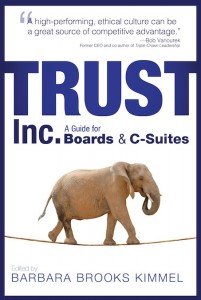
Late last year Trust Across America-Trust Around the World published the first in a planned series of award-winning books. TRUST INC., Strategies for Building Your Company’s Most Valuable Asset brings together the wisdom of 32 experts. Six months later we released our second book, Trust Inc. A Guide for Boards & C-Suites. In this book, sixty experts have joined forces to offer 100 strategies.
Throughout the month of August, we will be featuring 31 essays from our second book. Each stands alone as an excellent resource in guiding Boards and C-Suites on driving a trust agenda at the highest level in the organization, and provides tools for those who choose to implement trust-building programs in their organization.
This twelfth essay in our series brings advice from Linda Locke, a corporate reputation management expert and Senior Vice President at Standing Partnership. Locke previously served as the group head and senior vice president for Reputation and Issues Management for MasterCard Worldwide. Linda is a 2014 Top Thought Leader in Trustworthy Business and a member of the Alliance of Trustworthy Business Experts.
Three Ways to Build Trust
Trust-building is not a one-way road. I wish I had a dollar bill – okay a $50 bill – for every organization that asked me to improve perceptions by changing its name, buying advertising, or writing checks to charities.
Trust is the currency of organizational success. Strong trust enables organizations to achieve their goals; lack of trust can make it impossible. Trust can be built or destroyed several ways.
Direct experiences: Examine the experiences people have with your organization. Is customer service satisfying? Do you embrace every touch point as an opportunity to build trust through engagement? Or, are customer service calls an irritant? At the end of each engagement would the customer agree that his or her perspective was important?
What others say: In a connected world we are influenced by strangers. We actively seek input from people we think share our perspective or needs – including from legacy media, on networks and forums, and in conversations with our friends. A company that wants to build trust should listen to the public dialogue about itself and its industry, identify what drives perceptions, and share information throughout the organization to influence decision-making.
What the organization says about itself: The company’s leaders and spokespeople should articulate (authentically) the positive impact their work has on society. In times of crisis they should express empathy and commitment to resolving the situation.
People expect organizations to be savvy about the conversation going on around it. Organizations that are blind to the dialogue, and only communicate outward are unlikely to build and maintain the trust required to be a respected and trusted business in the modern world.
I hope you have enjoyed this next sneak peak into our second book. If this brief look behind the door has been helpful, follow this link to order both of our books online.
Barbara Brooks Kimmel is the Executive Director of Trust Across America-Trust Around the World whose mission is to help organizations build trust. She is also the editor of the award winning TRUST INC. book series. In 2012 Barbara was named “One of 25 Women Changing the World” by Good Business International.
. 

Should you wish to communicate directly with Barbara, drop her a note at Barbara@trustacrossamerica.com
Copyright © 2014, Next Decade, Inc.
Barbara Brooks Kimmel, barbara kimmel, corporate reputation, culture, leadership, Linda Locke, organizational trust, reputation, trust, trust across america, trust in business, Trust Inc. A Guide for Boards & C-Suites, Trust Inc. Strategies for Building Your Company's Most Valuable Asset, trustworthy behavior

It’s that time of summer again when my garden runneth over with every vegetable imaginable…. except zucchini. It’s not that I don’t attempt to grow it each year, the plants just NEVER produce any fruit. Truthfully, I don’t like zucchini unless it’s deep fried (which I won’t do) or made into bread (which is too much work.)
My neighbor likes zucchini. This is what he delivered from his garden to my kitchen.

So what does all this have to do with trust?
Organizations take trust for granted. Leaders assume trust just happens. But for organizations to be trustworthy and for stakeholders to trust them, trust must be cultivated. If it’s ignored or overlooked, if it’s not appreciated, if the weeds aren’t pulled, trust will not flourish. In the short term, the organization, like the zucchini may produce some nice leaves and yellow flowers but ultimately, it will wither on the vine before achieving it’s objective.
Barbara Brooks Kimmel is the Executive Director of Trust Across America-Trust Around the World whose mission is to help organizations build trust. She is also the editor of the award winning TRUST INC. book series. In 2012 Barbara was named “One of 25 Women Changing the World” by Good Business International.
. 

Should you wish to communicate directly with Barbara, drop her a note at Barbara@trustacrossamerica.com
Copyright © 2014, Next Decade, Inc.
Barbara Brooks Kimmel, barbara kimmel, leadership, trust, trust across america, Trust Inc. A Guide for Boards & C-Suites, Trust Inc. Strategies for Building Your Company's Most Valuable Asset, trustworthy behavior

Late last year Trust Across America-Trust Around the World published the first in a planned series of award-winning books. TRUST INC., Strategies for Building Your Company’s Most Valuable Asset brings together the wisdom of 32 experts. Six months later we released our second book, Trust Inc. A Guide for Boards & C-Suites. In this book, sixty experts have joined forces to offer 100 strategies.
Throughout the month of August, we will be featuring 31 essays from our second book. Each stands alone as an excellent resource in guiding Boards and C-Suites on driving a trust agenda at the highest level in the organization, and provides tools for those who choose to implement trust-building programs in their organization.
This eleventh essay in our series brings advice from Finland. Taina Savolainen is a Professor of Management and Leadership at the University of Eastern Finland, Business School and leader of the research group of Trust within Organizations. She is a trust trainer and educator focusing on inter-personal trust building skills.
Trust in the Boardroom
Competitive advantages strongly rest on creating and sharing knowledge in the boardroom where trust plays a significant role as an influential intangible asset for executives. Trust is a powerful resource for creating and facilitating cooperation between board members, CEO, etc. Managing trust successfully is a vital skill for senior executives. According to the recent report “The Trust Deficit”, on the views from the board room, interviewed business leaders were explicit that, not only was trust an important issue for business in general, but that it was particularly important for senior executives. Making trust-based judgments was thought to be an important skill for all in business. Business leaders felt the importance of this ability increased at higher levels within a business. Making trust-based decisions was seen as an especially important skill for business leaders, but also as an important responsibility discharged by board members (p. 24). Trustworthiness in business was expressed by one Chairman as follows “Trustworthy means, if you say you’re going to do something, you do it, and you don’t ever claim to be capable of doing something you’re not capable of, and if something goes wrong, you fix it…” (p. 14) ( Chairman, FTSE 250, The Trust Deficit: Views from the Boardroom.)
I hope you have enjoyed this next sneak peak into our second book. If this brief look behind the door has been helpful, follow this link to order both of our books online.
Barbara Brooks Kimmel is the Executive Director of Trust Across America-Trust Around the World whose mission is to help organizations build trust. She is also the editor of the award winning TRUST INC. book series. In 2012 Barbara was named “One of 25 Women Changing the World” by Good Business International.
. 

Should you wish to communicate directly with Barbara, drop her a note at Barbara@trustacrossamerica.com
Copyright © 2014, Next Decade, Inc.
Barbara Brooks Kimmel, barbara kimmel, boardroom, leadership, Taina Savolainen, trust, trust across america, trust in business, Trust Inc. A Guide for Boards & C-Suites, Trust Inc. Strategies for Building Your Company's Most Valuable Asset, trustworthy behavior

Late last year Trust Across America-Trust Around the World published the first in a planned series of award-winning books. TRUST INC., Strategies for Building Your Company’s Most Valuable Asset brings together the wisdom of 32 experts. Six months later we released our second book, Trust Inc. A Guide for Boards & C-Suites. In this book, sixty experts have joined forces to offer 100 strategies.
Throughout the month of August, we will be featuring 31 essays from our second book. Each stands alone as an excellent resource in guiding Boards and C-Suites on driving a trust agenda at the highest level in the organization, and provides tools for those who choose to implement trust-building programs in their organization.
This tenth essay in our series brings advice from Israel and my friend Lilach Felner, a Marketing Consultant helping companies become trustworthy. She has developed the Trust-based Strategy Model that was included in an essay written by Patricia Aburdene contained in our book, Trust Inc. Strategies for Building Your Company’s Most Valuable Asset. She is also the Founder of I Trust U. itrustu.biz
Warning: Don’t Drown in the Slogan Swamp Given deterioration in consumer trust, we are witnessing more and more activities and initiatives coming from organizations and brands regarding the trend I’ve called “FOR THE” (for the community, for the environment, for the weak). In today’s atmosphere, terms like Corporate Social Responsibility, Corporate Citizenship, Sustainable Responsible Business, Environmental Sustainability, are popping up like mushrooms.
But these beautiful initiatives can sometimes turn into a threatening danger. A danger I call “The Trap of Drowning into Slogans” When can this danger occur? In order to answer this critical question, we have to look in the mirror in the most sincere way and examine the real motive for these acts:
- Were they initiated because of our incompetence in dealing with the crisis in trust emanating from our consumers?
- Were they initiated as an alternative tool to our traditional marketing tools that have been tainted by consumers who consider these tools to be manipulative, self-interested and exploitative?
- Were they initiated only to distract consumers from ethical questions posed by our core operations?If the answer to these questions is YES, then we are deeply stuck in the “Slogan Swamp”.Our consumers are smart and clever and are telling us: “NO MORE”. No more lies. No more tricks. No more masks.As long as we don’t change something from within, as long as we keep on pretending, keep on lying to ourselves, we will keep on drowning in this downward swamp.
I hope you have enjoyed this next sneak peak into our second book. If this brief look behind the door has been helpful, follow this link to order both of our books online.
Barbara Brooks Kimmel is the Executive Director of Trust Across America-Trust Around the World whose mission is to help organizations build trust. She is also the editor of the award winning TRUST INC. book series. In 2012 Barbara was named “One of 25 Women Changing the World” by Good Business International.
. 

Should you wish to communicate directly with Barbara, drop her a note at Barbara@trustacrossamerica.com
Copyright © 2014, Next Decade, Inc.
Barbara Brooks Kimmel, barbara kimmel, corporate reputation, integrity, leadership, Lilach Felner, organizational trust, trust, trust across america, trust in business, Trust Inc. A Guide for Boards & C-Suites, Trust Inc. Strategies for Building Your Company's Most Valuable Asset, trustworthy behavior, values







Recent Comments